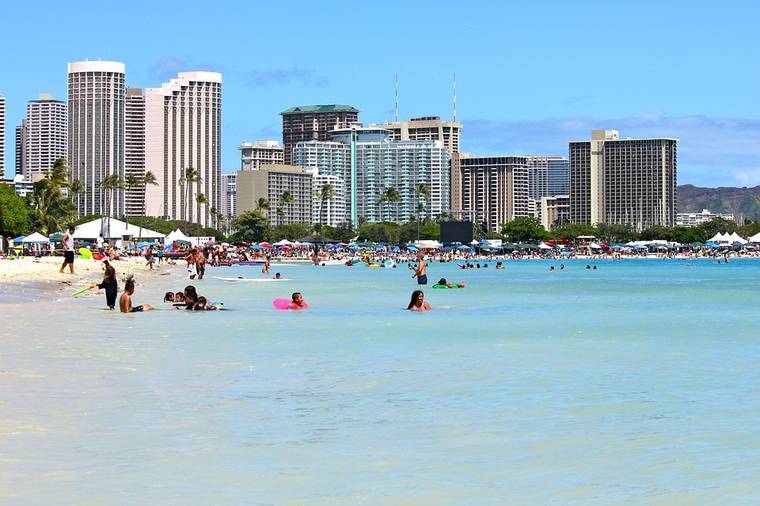HONOLULU — The economic impact to Hawaii of Waikiki Beach was recently estimated at $2.2 billion a year, but the crumbling Royal Hawaiian groin and other man-made structures are all that is keeping the state’s most visited beach from being swept away.
The concrete groin was erected around 1927 to protect structures along the coastline and to create the sandy beach that has made Waikiki so famous. It’s been failing for years with no immediate timeline for replacement until now.
The state budget passed by the Legislature this year includes some $13 million in Waikiki Beach funding, enough to shore up the Royal Hawaiian groin, located between the between the Waikiki Sheraton and Royal Hawaiian hotels, and return a groin to Kuhio Beach where erosion periodically exposes old foundation from the Waikiki Tavern, which was built in 1928 and demolished in 1962.
It’s also enough to fund a $10 million Waikiki Beach Master Plan that would include another four or so projects.
“This is the largest appropriation for beach improvements on Oahu in recent memory. It allows us to move forward on several projects that have been discussed on and off for decades,” said Dolan Eversole, Waikiki Beach management coordinator for the University of Hawaii Sea Grant College Program.
“That’s a good thing since people are starting to see the reality of sea level rise on Waikiki Beach,” said Eversole, who is coordinating a private partnership between the state Department of Land and Natural Resources and the Waikiki Beach Special Improvement District Association. “There used to be a wait-and-see sentiment among some, especially the Waikiki beach boys, but there has been a shift in overall perception and people seem to feel that we can’t wait any longer to address these challenges.”
Much is at stake since Waikiki Beach is the epicenter of Oahu’s visitor industry. Last year, the island welcomed more than 5.9 million tourists, or about 60% of the state’s total count of nearly 10 million visitors. They accounted for more than $8 billion in visitor spending, or about 46% of the statewide tally of $17.8 billion.
To put it bluntly, Waikiki Beach is synonymous with Hawaii, said Nerida Abbott, a repeat visitor from Melbourne, Australia.
“In Australia, Waikiki is better known than Oahu. Waikiki Beach is the main attraction. It’s the reason everyone wants to come to Hawaii,” said Abbott, who was traveling in a family party of 10. “We came in 2017. If Waikiki Beach wasn’t here, we probably wouldn’t have come back.”
Abbott, who was frolicking on the beach with her family near the Duke Kahanamoku statute, was excited to hear about planned beach improvements, especially since she noted that portions of Kuhio Beach are much narrower than the sandy stretch fronting the Hilton Hawaiian Village at the opposite end of Waikiki.
“It would be great to have more space here,” she said.
Chris Tatum, president and CEO of Hawai’i Tourism Authority, said the agency supports the state’s efforts to protect Waikiki Beach, which is an iconic place for locals and visitors to enjoy.
“Waikiki Beach’s historic and cultural significance dates back to Mailikukahi, who established his seat of government here in the 15th century. Today, it is one of the most renowned beaches in the world and is also tremendously important to the Hawaii brand image,” Tatum said.
Eversole said the new push is the most exciting news for the district since 2015, when the Honolulu City Council approved the creation of the Waikiki Beach Special Improvement District Association, which this year will raise about $1 million from assessments levied on commercial operators in the special tax district bounded by Kapahulu Avenue, Ala Wai Canal and Ala Wai Small Boat Harbor. Now in its fourth year, the association has allowed Waikiki businesses to partner with the city and state to plan for and fund services and improvements to Waikiki Beach. In addition to funding half of the Kuhio and Royal Hawaiian groin costs, the association has committed to covering approximately $3 million of the master plan’s cost.
Last year, the Royal Hawaiian groin project didn’t make it into the state budget, but this year lawmakers universally agreed that it and more was needed, said Rep. Tom Brower (D,Waikiki-Ala Moana-Kakaako).
“The Legislature was always willing to put the money there provided it was ready to be spent on the right projects,” Brower said. “The timing of this was right. Now we have people who can oversee the future management of these erosive areas.”




